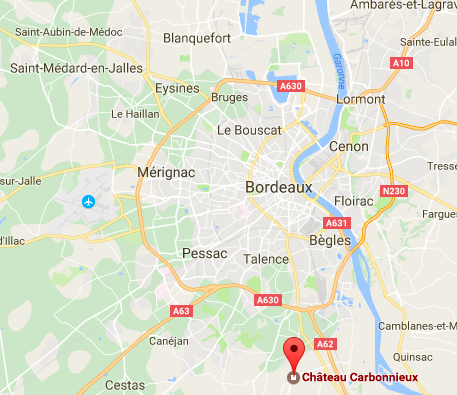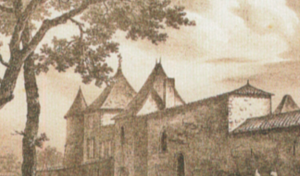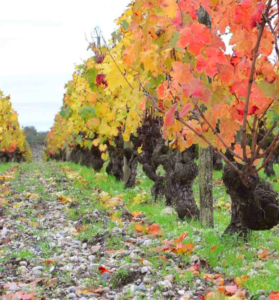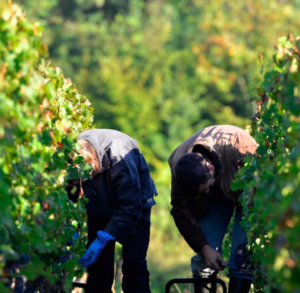

Overview

Located just ten miles from Bordeaux near the Garonne, the vineyards at Château Carbonnieux are situated on a rise in the land, on gravel rich soils typical of the area. Near neighbors include Smith-Haut-Lafitte and Haut-Bailly, both to the south. Château Carbonnieux is one of the classified Graves châteaux, and produces both red and white cuvées under the Pessac-Léognan appellation.
History
The medieval origins of the estate were confirmed by a deed of exchange dated April 2, 1292 signed by two monks from the powerful Sainte-Croix abbey in Bordeaux. In 1519 after the difficulties of the Hundred Years War, the Benedictine monks from Sainte Croix sold the Carbonnieux land to Jean de Ferron. Jean de Ferron who came from a powerful Bordeaux bourgeois family, that already owned vines, had recently been ennobled and to glorify his rank had to own a great vineyard in the Graves region. As new Lord of Carbonnieux, he started a land purchase and consolidation policy which continued under his successors for two and a half centuries.
 Formally a fortified farm, the Ferron noble house gradually became the great domain that it is today with its inner courtyard, high towers, outhouses, cropland and great vineyard. Although raised to the status of « Lords of Carbonnieux » the Ferron family ran into debt and sold the estate to the monks of the Sainte-Croix abbey in Bordeaux. Don Galléas was one of the first to blend varieties and to bottle wine which made it easier for it to be transported and kept for longer before being drunk. His vinification methods and his cellars were among the most modern in the region.
Formally a fortified farm, the Ferron noble house gradually became the great domain that it is today with its inner courtyard, high towers, outhouses, cropland and great vineyard. Although raised to the status of « Lords of Carbonnieux » the Ferron family ran into debt and sold the estate to the monks of the Sainte-Croix abbey in Bordeaux. Don Galléas was one of the first to blend varieties and to bottle wine which made it easier for it to be transported and kept for longer before being drunk. His vinification methods and his cellars were among the most modern in the region.
Thanks to the talents and entrepreneurship of the Benedictine monks from the Sainte-Croix abbey for half a century, the domain flourished and the famous bottle with the Saint Jacques shell attained worldwide renown, from Constantinople to the United States. In fact, during the 18th century when times were particularly good for the port of Bordeaux, the monks managed to introduce the clear white wines of Carbonnieux, with their pale colour into the palace of the Ottoman Sultan and called them « The mineral water of Carbonnieux ». The trick worked because one of his favourites was a woman from Bordeaux who had been captured by pirates and given to the Prince of the harem. The legend even goes so far as to say that the Prince asked « why do the French make wine when they have such delicious mineral water ? »
 In 1786, Thomas Jefferson, the future president of the United States, a gastronome and great wine lover went on a grand tour of France to discover its vineyards. In Bordeaux he selected a few famous estates and his diary shows that he came to Carbonnieux to taste the « Wine of the Odalisques » as it was then called in the United States.
In 1786, Thomas Jefferson, the future president of the United States, a gastronome and great wine lover went on a grand tour of France to discover its vineyards. In Bordeaux he selected a few famous estates and his diary shows that he came to Carbonnieux to taste the « Wine of the Odalisques » as it was then called in the United States.
There was a terrible frost in the winter of 1956 and it was this same year that Marc Perrin who had bought the estate, set to work on the renovation of the château and its vineyard. He first started a significant replanting campaign that took the estate to 45 Ha in 1970 then to 70 Ha in 1980, to reach almost 95 Ha today. His son, Antony, built a new fermentation cellar and modernized the cellars to adapt to new vinification methods. He continued the restoration of the château and the vineyards and focused on increasing the renown of Carbonnieux and Bordeaux wine throughout the world. He was president of the « Union of Grand Crus de Bordeaux », president of the « Crus Classés de Graves » as well as being one of the forerunners of the Pessac-Léognan appellation, created in 1987. He also purchased newestates in the appelation Château Le Sartre and bois Martin which today belong to his sister. Over the yeards he passed on the family winemaking heritage and his skills to his children. Today the torch has been passed on them and once again the estate has reached a peak.
The Terroir
 Sustainable agriculture classification for all the vineyard practices (chemical insecticides, weed-killers and acarides are banned).
Sustainable agriculture classification for all the vineyard practices (chemical insecticides, weed-killers and acarides are banned).
Carbonnieux is a member of the ISO 14001 Certified Bordeaux Environmental Management System Association.
Soil : Multiples plots with differents soils ; clay and gravel / gravel / clay and limestone / sand and gravel / argillaceous vein / limestone vein.
Acreage :
-50 Ha for red grape varieties (60% Cabernet Sauvignon, 30% Merlot, 7% Cabernet Franc, 3% Petit Verdot)
-42 Ha for white grape varieties (65% Sauvignon blanc, 35% Sémillon)
Harvesting : done by hand by local people who are familiar with the vineyards
Vinification
White
Little vibrating tippers place the bunches of harvested grapes gently on the sorting table. The white grapes, cleaned manually, arrive in three of the latest model pneumatic Inertys presses (under inert gas) where they are pressed, with or without the stems in oxygen free conditions. The first very clear aromatically subtle juices can be obtained after this type of slow gentle pressing. The absence of oxidation throughout the pressing process helps the naturally very pale juices to keep their fruity quality and to limit the use of sulphur. After 3 to 4 days of settling in vats at low temperature, fermentation continues in barrels, by batches depending on the plots they originally came from.
Red
Once they are placed on the table, the red grapes are sorted twice, before and after destemming, in order to get rid of any unwanted vegetable particles. After gentle crushing, the berries are put in vats with their skins to extract the tannins and the colour. The vatting process of red juices lasts around 28 days at low temperature and involves regular pumping over. The marc cap gently pumped over will give the wine the deep colour that characterizes the reds from Château Carbonnieux. When fermentation is finished the wines are drained by gravity into settling barrels, batch by batch , to start the ageing process.
Aging
 White
White
White wines are put in barrels of different capacities (225 litres, 400litres and oak vats) depending on the oak flavor desired. During the 10 months of ageing the different batches of white wines are stirred regularly. Thanks to this ancestral manual stirring process, the fine lees are suspended in the barrel to lend body and fullness to the wines.
The cellar for white wines contains the equivalent of 600 oak barrels from the centre of France. A quarter are renewed every year.
Red
Once they are barreled, red wines start the malolactic fermentation process which lowers acidity and gives them more roundness. The ageing of red wines lasts about 18 months in Bordeaux barrels. Slowly the tannins from the wood blend with those from the wine to produce more subtle aromas.
Oxygen that passes slowly between the staves of the barrels very gently matures the wine and the “angel’s share” is exhaled. Due to this natural loss the level of the barrels must be topped up regularly.
The red wine cellar contains around 1000 oak barrels from the centre of France. A third are renewed every year.
Blending
Each barrel is identified by its plot of origin and grape variety. At the end of the ageing process, blending gives life to the different wines. The best batches, offering outstanding gustatory qualities and cellaring potential, are selected for the red and white Carbonnieux wines. The other plots will be used to craft La Croix de Carbonnieux and Château Tour Léognan. After the painstaking blending process, the wines are fined (with egg whites for red wines and a natural mineral clay for white wines) to precipitate the last suspended micro-particles. The wines are then ready for bottling. The bottles rest in our cellars for a few months before delivery.
Crafted by the Perrin Family for more than a half-century, the great wines of Château Carbonnieux, red or white are then ready to join your cellar and grace your table.

Chateau Carbonnieux Rouge
Vinification: The vinification is carried out by slow and gentle extraction in order to preserve the roundness of the wine and the mineral features of the soil. The tannins are well balanced and silky in harmony with red fruit notes (blackcurrant, blackberry, cherry) and reveal toasted notes from aging in the finest quality French oak barrels. Only the very best batches tasted are selected for the final blending of Château Carbonnieux red.
Aging: 16-18 months in barrels (35% new oak)
Grape Blend: Cabernet Sauvignon, Merlot, Cabernet Franc
Winemaker Notes: “Its deep colour, complexity and fruity intensity, freshness and tannic density allow you to imagine its enormous potential. A wine that can be kept for a very long time.”
Food Pairings: Grilled, roasted, or stewed meats, swordfish, tuna fish, cheese, chocolate desserts, etc.
Serving Temperature: 18-19°C
Cellaring Potential: 6 years minimum

Chateau Carbonnieux Blanc
Appellation: Pessac-Léognan
Production Area: 42 ha
Soil: Clay-gravel and clay-limestone
Average Age of Vines: 28 years
Grape Blend: Sauvignon Blanc, Sémillon
Vineyard Management: Sustainable agriculture
Pruning: Cot or Guyot-poussart
Harvest: Hand harvesting. The grapes are sorted on the wine and on the sorting table.
Vinification: Gentle and slow pressing using inert gas – cold clarification. Fermenting and aging in oak barrels (2 volumes) and oak vats.
Aging: Barrel aging for 10 months (25% new oak) with lees stirring.
Average Yield: 25hl/ha

Château Tour Leognan Rouge
Overview: Château Tour Léognan was originally a separate estate bordering Château Carbonnieux. When Marc Perrin acquired the two properties in 1956 and began a program of replanting the vineyard, Château Tour Léognan became the second wine of Carbonnieux. From the start, its wines have been crafted from the young Château Carbonnieux vines (under 12 years old). Each year, 3 hectares (7.5 acres) are pulled up and replanted 2 or 3 years later.
A blend of Cabernet Sauvignon and Merlot, the red wines reflect the rich mineral variety of the soils, so specific to the Pessac-Leognan terroir. They are full-bodied, well-balanced and slightly oaky. Lively, aromatic, dynamic, and fruity, the white wines of Château Tour Leognan are decidedly very pleasant and easy to drink when young. The red wines are best enjoyed around 5 years old, and the whites around 3 years old.
Owner: SCEA A. Perrin & Fils
Co-Managers: Eric & Philibert Perrin
Vineyard Master: Freddy Flé
Oenologist: Andréa Perrin
Consultant: Christophe Ollivier
Appellation: Pessac-Léognan
Production Area: 10 ha
Soil: Deep gravel and clay-limestone
Grape Blend: Cabernet-Sauvignon, Merlot
Planting Density: 7,200 vines/ha
Average Age of Vines: 8 years
Viticulture: Environmentally friendly growing for sustainable agriculture (Member of the 1st ISO 14001 certified Bordeaux EMS Association). HVE3 Labelled (High Environmental Value Level 3)
Training Method: Cot or Guyot-Poussart pruning
Harvest: Hand picking – 3 grape sortings
Vinification: Vatting 3-4 weeks in temperature-controlled stainless-steel tanks
Aging: Barrel aging for 12 months (30-40% new oak)
Tasting Notes: Round, fruity, and lightly oaked, making it easily approachable when young. Moreover, it is marked by the mineral notes and smoky character which is so appreciated in wines from Léognan.

Château Tour Léognan Bordeaux Blanc Sec
Overview: Château Tour Léognan is produced from young vines grown on the estate of Chateau Carbonnieux. Château Carbonnieux employs sustainable agriculture on all of its properties, meaning all chemical insecticides, weed-killers, and acaricides are banned and replaced by environmentally friendly methods that better respect biodiversity and allow the vine plant to stimulate its own natural defenses.
Production Area: 5 ha
Soil: Deep gravel & clay-limestone
Average Age of the Vines: 10 years old
Grape Blend: Sauvignon Blanc, Sémillon
Vinification: The grapes are hand harvested with great care, then gently crushed in oxygen-free conditions using a pneumatic press. After 3-4 days of settling in vats at low temperature, fermentation continues in barrels by batches, depending on the plots they originally came from.
Aging: The wine is matured in 30% new oak barrels for 9 months, with lees stirring which lends body and fullness to the wine. After blending, the wine is fined using a natural mineral clay. The wines are then bottled and left to rest in the cellars for a few months before delivery.
Annual Production: 30,000 bottles
Tasting Notes: This wine is a pure pleasure to drink; there are notes of citrus in the bouquet and a fleshy, elegant mouth feel. This lively and fruity blend is rounded out by the sweetness and fattiness of the Sémillon grapes.
Food Pairings: Oysters, fish, seafood, raclette, white meat, goat cheese, citrus desserts
Serving Temperature: 12- 14°C


